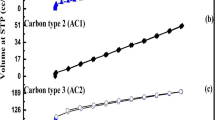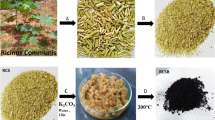Abstract
Cement waste (CW) is one of the main environmental problems in the cement industry due to the high amount that is used and its incorrect disposal. This makes it an environmental burden and management actions are required for this waste product. In this context, the present work aimed to evaluate the adsorption capacity of rhodamine dye using a biosorbent (activated carbon from cement waste—AC-CW) through the study of equilibrium (Langmuir, Freundlich, and Sips models) and kinetic (pseudo-first-order, second-order, and intraparticle diffusion models) adsorption. For the preparation of AC-CW, an activation/carbonization process was used, where ZnCl2 was used as the activating reagent at a proportion of 1:2 w/w, with a heating rate of 10 °C min−1 to 600 °C for 240 min. Samples were characterized by a scanning electron microscope with energy dispersion spectroscopy, Zero Charge Point (pHZCP), Fourier transform infrared spectroscopy (FTIR), N2 porosimetry (BET/BJH methods), and zeta potential. Adsorption was adequate using 1.0 g L–1 AC-CW, and the process was most efficient at pH ≈ 4.3 for RhB dye adsorption. From the kinetic adsorption viewpoint, the data were satisfactorily represented by the pseudo-first-order model. The Sips model was suitable to represent the adsorption equilibrium of the RhB dye. The maximum adsorption capacity was determined to be 531.836 mg g–1. Thus, AC-CW was an efficient adsorbent material able to uptake dye from aqueous solutions.








Similar content being viewed by others
References
Mandaric L, Diamantini E, Stella E, Cano-Paoli K, Valle-Sistac J, Molins-Delgado D, Bellin A, Chiogna G, Majone B, Diaz-Cruz MS, Sabater S, Barcelo D, Petrovic M (2017) Contamination sources and distribution patterns of pharmaceuticals and personal care products in Alpine rivers strongly affected by tourism. Sci Total Environ 590–591:484–494. https://doi.org/10.1016/j.scitotenv.2017.02.185
Noorhosseini SA, Allahyari MS, Damalas CA, Moghaddam SS (2017) Public environmental awareness of water pollution from urban growth: the case of Zarjub and Goharrud rivers in Rasht. Iran Sci Total Environ 599–600:2019–2025. https://doi.org/10.1016/j.scitotenv.2019.133595
Bhatia D, Sharma NR, Singh J, Kanwar R (2017) Biological methods for textile dye removal from wastewater: a review. Crit Rev Env Sci Technol 47:1836–1876. https://doi.org/10.1080/10643389.2017.1393263
Piaskow K, Świderska-Dąbrowska R, Zarzycki PK (2018) Dye removal from water and wastewater using various physical, chemical, and biological processes. J AOAC Int 10:1371–1384. https://doi.org/10.5740/jaoacint.18-0051
Hernández-Montoya V, Pérez-Cruz MA, Mendoza-Castillo DI, Moreno-Virgena MR, Bonilla-Petriciolet A (2013) Competitive adsorption of dyes and heavy metals on zeolitic structures. J Environ Manage 116:213–221. https://doi.org/10.1016/j.jenvman.2012.12.010
Thue PS, Sophia C, Lima E, Wamba AGN, De Alencar WS, Dos Reis GS, Rodembusch FS, Dias SLP (2018) Synthesis and characterization of a novel organic-inorganic hybrid clay adsorbent for the removal of acid red 1 and acid green 25 from aqueous solutions. J Clean Prod 171:30–44. https://doi.org/10.1016/j.jclepro.2017.09.278
Smith KM, Fowler GD, Pullket S, Graham NJD (2009) Sewage sludge-based adsorbents: a review of their production, properties and use in water treatment applications. Water Res 43:2569–2594. https://doi.org/10.1016/j.watres.2009.02.038
Kaur K, Mor S, Ravindra K (2016) Removal of chemical oxygen demand from landfill leachate using cow-dung ash as a low-cost adsorbent. J Colloid Interface Sci 469:338–343. https://doi.org/10.1016/j.jcis.2016.02.025
Martins R, Pardo R, Boaventura R (2004) Cadmium (II) and zinc (II) adsorption by aquatic moss Fontinalis antipyretica: effect of temperature, pH and water hardness. Water Res 28:693–699. https://doi.org/10.1016/j.watres.2003.10.013
Crini G, Badot PM (2007) Application of chitosan, a natural aminopolysaccharide, for dye removal from aqueous solutions by adsorption processes using batch studies: a review of recent literature. Prog Polym Sci 33:399–447. https://doi.org/10.1016/j.progpolymsci.2007.11.001
Mohan D, Singh KP, Singh VK (2008) Wastewater treatment using low cost activated carbons derived from agricultural byproducts A case study. J Hazard Mate 152:1045–1053. https://doi.org/10.1016/j.jhazmat.2007.07.079
Salleh MAM, Mahmoud DK, Karim WAWA, Idris A (2011) Cationic and anionic dye adsorption by agricultural and solid wastes: a comprehensive review. Desalination 280:1–13. https://doi.org/10.1016/j.desal.2011.07.019
Srivastava S, Sinha R, Roy D (2004) Toxicological effects of malachite green. Aquat Toxicol 66:319–329. https://doi.org/10.1016/j.aquatox.2003.09.008
Ferreira JM, Silva FLH, Alsina OLS, Oliveira LSC, Cavalcanti EB, Gomes WC (2007) Study of balance and kinetics of Pb2+ biosorption by Saccharomyces cerevisiae. Quim Nova 30:1188–1193. https://doi.org/10.1590/S0100-40422007000500026
Moura JM, Grundmann DDR, Cadaval Jr TRS, Dotto GLM, Pinto LAA (2016) Comparison of chitosans with different physical forms to remove reactive black 5 from aqueous solution. J Environ Chem Eng 4:2259–2267. https://doi.org/10.1016/j.jece.2016.04.003
Luo L, Xu C, Chen Z, Zhang S (2015) Properties of biomass-derived biochars: combined effects of operating conditions and biomass types. Bioresour Technol 192:83–89. https://doi.org/10.1016/j.biortech.2015.05.054
Joseph SD, Arbestain MC, Lin Y, Munroe P (2010) An investigation into the reactions of biochar in soil. Aust J Soil Res 48:501–515. https://doi.org/10.1071/SR10009
Huang H, Yuan X, Zeng G, Wang J, Li H, Zhou C, Pei X, You Q, Chen L (2011) Thermochemical liquefaction characteristics of microalgae in sub-and super- critical ethanol. Fuel Process Technol 92:147–153. https://doi.org/10.1016/j.fuproc.2010.09.018
Patel M, Zhang X, Kumar A (2016) Techno-economic and life cycle assessment on lignocellulosic biomass thermochemical conversion technologies: a review. Renew Sustain Energy Rev 53:1486–1499. https://doi.org/10.1016/j.rser.2015.09.070
Libra JA, Ro KS, Kammann C, Funke A, Berge ND, Neubauer Y, Titirici MM, Fühner C, Bens O, Kern J, Emmerich KH (2011) Hydrothermal carbonization of biomass residuals: a comparative review of the chemistry, processes and applications of wet and dry pyrolysis. Biofuels 2:71–106. https://doi.org/10.4155/bfs.10.81
Figueiredo VM, Lourenço JB, De Vasconcellos NJS, Da Silva WL (2020) Preparation, characterization and photocatalytic activity of activated charcoal from microalgae for photocatalytic degradation of rhodamine B dye. Ceramics 66:367–372. https://doi.org/10.1590/0366-69132020663802937
Postai DL, Demarchi CA, Zanatta F, Melo DCC, Rodrigues CA (2016) Adsorption of rhodamine B and methylene blue dyes using waste of seeds of Aleurites Moluccana, a low cost adsorbent. Alex Eng J 55:1713–1723. https://doi.org/10.1016/j.aej.2016.03.017
Langmuir I (1918) The adsorption of gases on plane surface of glass, mica and platinum. J Am Chem Soc 40:1361–1403. https://doi.org/10.1021/ja02242a004
Freundlich HMF (1906) Over the adsorption in solution. J Phys Chem 57:385–471
Sips R (1948) The structure of a catalyst surface. J Chem Phys 16(490–495):1948. https://doi.org/10.1063/1.1746922
Lagergren S (1898) About the theory of so-called adsorption of soluble substances. Kungliga Svenska Vetenskapsakademiens Handlingar 24:1–39
Ho YS, Mckay G (1998) Kinetic models for the sorption of dye from aqueous solution by wood. Process Saf Environ 76:183–191. https://doi.org/10.1205/095758298529326
Elovich SY, Larionov OG (1962) Theory of adsorption from nonelectrolyte solutions on solid adsorbents. Russ Chem B 11:198–203. https://doi.org/10.1007/BF00908017
Dotto GL, Moura JM, Cadaval TRS, Pinto LAA (2013) Application of chitosan films for the removal of food dyes from aqueous solutions by adsorption. Chem Eng J 214:8–16. https://doi.org/10.1016/j.cej.2012.10.027
Kinney TJ, Masiello CA, Dugan B, Hockaday WC, Dean MR, Zygourakis K (2012) Hydrologic Yorikis properties of biochars produced at different temperatures. Biomass Bioenerg 41:34–43. https://doi.org/10.1016/j.biombioe.2012.01.033
Enders A, Hanley K, Whitman T, Joseph S, Lehmann J (2012) Characterization of biochars to evaluate recalcitrance and agronomic performance. Bioresource Technol 114:644–653. https://doi.org/10.1016/j.biortech.2012.03.022
Lehmann J, Joseph S (2009) Biochar for environmental management: an introduction. In: Lehmann J, Joseph S (eds) Biochar for environmental management science and technology, 2nd edn. Earthsca, New York, pp 1–9
Kan T, Strezov V, Evans TJ (2016) Lignocellulosic biomass pyrolysis: A review of product properties and effects of pyrolysis parameters. Renew Sustain Energ Rev 57:126–1140. https://doi.org/10.1016/j.rser.2015.12.185
Mehta PK, Monteiro PJM (2006) Concrete: microestructure, properties and materials. McGraw-Hill Professional, New York
Hosain ANA, Nemr AE, Sikaily AE, Mahmoud E, Amira MF (2020) Surface modifications of nanochitosan coated magnetic nanoparticles and their applications in Pb(II), Cu(II) and Cd(II) removal. J Environ Chem Eng 8:104316–104329. https://doi.org/10.1016/j.jece.2020.104316
Mall ID, Srivastava DC, Agarwal NK (2006) Removal of orange-g and methyl violet dyes by adsorption onto bagasse fly ash-kinetic study and equilibrium isotherm analyses. Dyes Pigments 69:210–223. https://doi.org/10.1016/j.dyepig.2005.03.013
Silverstein RM, Webster FX, Kiemle DJ (2005) Spectrometric identification of organic compounds. Wiley, Nova Jersey
IUPAC (2015) International union of pure and applied chemistry. Pure Appl Chem 87:1051–1069. https://doi.org/10.1515/pac-2014-1117
Albanio II, Muraro PCL, Da Silva WL (2021) Rhodamine B dye adsorption onto biochar from olive biomass waste. Water Air Soil Pollut 232:214–221. https://doi.org/10.1007/s11270-021-05110-6
Yagub MT, Sen TK, Afroze S, Ang HM (2014) Dye and its removal from aqueous solution by adsorption: a review. Adv Colloid Interface Sci 209:172–184. https://doi.org/10.1016/j.cis.2014.04.002
Salleh MAM, Mahmound DK, Karim WAW, Idris A (2011) Cationic and anionic dye adsorption by agricultural solid wastes: a comprehensive review. Desalination 280:1–13. https://doi.org/10.1016/j.desal.2011.07.019
Hadi P, Xu M, Ning C, Sze C, Lin K, Mckay G (2015) A critical review on preparation, characterization and utilization of sludge–derived activated carbons for wastewater treatment. Chem Eng J 260:895–906. https://doi.org/10.1016/j.cej.2014.08.088
Li WH, Yue QY, Gao BY, Ma ZH, Li YJ, Zhao HX (2011) Preparation and utilization of sludge–based activated carbon for the adsorption of dyes from aqueous solutions. Chem Eng J 171:320–327. https://doi.org/10.1016/j.cej.2011.04.012
Vimonses V, Lei S, Jin B, Chow CWK, Saint C (2009) Kinetic study and equilibrium isotherm analysis of congo red adsorption by clay materials. Chem Eng J 148:354–364. https://doi.org/10.1016/j.cej.2008.09.009
Giles CH, Smith D, Huitson A (1974) A general treatment and classification of the solute adsorption isotherm. I. Theoret J Colloid Interface Sci 47:755–765. https://doi.org/10.1016/0021-9797(74)90252-5
Bensalah J, Habsaoui A, Dagdag O, Lebkiri A, Ismi I, Rifi EH, Warad I, Zarrouk A (2021) Adsorption of a cationic dye (Safranin) by artificial cationic resins Amberlite®IRC-50: equilibrium, kinetic and thermodynamic study. Chem Data Collect 35:100756. https://doi.org/10.1016/j.cdc.2021.100756
Wang H, Li Z, Yahyaoui S, Hanafy H, Seliem MK, Dotto GL, Sellaoui L, Li Q (2020) Effective adsorption of dyes on an activated carbon prepared from carboxymethyl cellulose: experiments, characterization and advanced modelling. Chem Eng J 417:128116–128151. https://doi.org/10.1016/j.cej.2020.128116
Acknowledgements
We thank the Polytechnical School of Chemical Engineering at the University of São Paulo (USP, Brazil – SP) for their support and assistance in carrying out the present work. This work received financial support from the Foundation for Research of the State of Rio Grande do Sul (FAPERGS–Project 19/2551-0001606-9).
Author information
Authors and Affiliations
Contributions
WL Da Silva: conceptualization, data curation, formal analysis, investigation, validation, writing—original draft, and writing—review and editing. PCL Muraro: conceptualization, and writing—review and editing. G Pavoski: conceptualization, and writing—review and editing. DCR Espinosa: conceptualization, and writing—review and editing. JHZ Dos Santos: conceptualization, data curation, formal analysis, investigation, validation, writing—original draft, and writing—review and editing.
Corresponding authors
Additional information
Publisher's Note
Springer Nature remains neutral with regard to jurisdictional claims in published maps and institutional affiliations.
Rights and permissions
About this article
Cite this article
da Silva, W.L., Muraro, P.C.L., Pavoski, G. et al. Preparation and characterization of biochar from cement waste for removal of rhodamine B dye. J Mater Cycles Waste Manag 24, 1333–1342 (2022). https://doi.org/10.1007/s10163-022-01416-7
Received:
Accepted:
Published:
Issue Date:
DOI: https://doi.org/10.1007/s10163-022-01416-7




